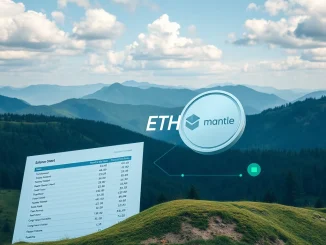
The cryptocurrency world is buzzing with a monumental achievement: BlackRock’s iShares Ethereum Trust (ETHA) has shattered expectations, surging to an astounding $10 billion in assets under management (AUM) in just 251 days. This incredible feat positions ETHA as the third-fastest ETF in history to reach this milestone, trailing only two spot Bitcoin funds. This remarkable growth underscores a pivotal shift in the financial landscape, signaling robust institutional crypto interest and a maturing market for digital assets. For anyone tracking the pulse of the crypto market, this development is a clear indicator of Ethereum’s growing mainstream acceptance.
BlackRock ETHA’s Meteoric Rise: A New Benchmark for ETFs
BlackRock’s ETHA has not just grown; it has exploded. The fund’s journey to $10 billion in AUM was capped by an impressive $5 billion inflow over a mere 10-day period ending July 23. This surge marks the fastest growth from $5 billion to $10 billion ever recorded in ETF history. Bloomberg Senior ETF Analyst Eric Balchunas aptly described this performance as the “ETF asset equivalent of a God candle,” a testament to the rare combination of soaring demand and substantial investor flows.
To put ETHA’s rapid ascent into perspective, consider these benchmarks:
- ETHA: $10 billion in 251 days.
- iShares Bitcoin Trust (IBIT): $10 billion in 34 days.
- Fidelity Wise Origin Bitcoin Fund (FBTC): $10 billion in 53 days.
- JPMorgan’s Nasdaq Equity Premium Income ETF (JEPQ): $10 billion in 444 days.
While ETHA lags behind its Bitcoin counterparts, its performance significantly outpaces traditional benchmarks, demonstrating the unprecedented speed at which crypto-focused investment products are attracting capital. This rapid adoption highlights a fundamental shift in investor sentiment towards digital assets.
Understanding the ETH Price Surge and ETF Interplay
The success of BlackRock ETHA is intrinsically linked to the performance of Ethereum itself. The ETF’s rapid ascent aligns perfectly with a significant ETH price surge, which saw Ethereum approaching $3,850 in early July—its highest level since December 2024—before settling around $3,710. Analysts observe a compelling feedback loop between ETHA’s inflows and Ethereum’s price action. As Balchunas noted, “Flows and price are like tangoing,” emphasizing a symbiotic relationship where each factor reinforces the other without a single, clear cause.
This surge in Ethereum’s value and ETF inflows has coincided with broader optimism across the crypto landscape. A key catalyst has been the U.S. Congress’s passage of the GENIUS Act. This legislation aims to provide much-needed clarity on regulatory frameworks for digital assets, a development widely expected to bolster Ethereum’s robust stablecoin infrastructure and overall ecosystem. Such regulatory advancements reduce uncertainty, making the asset class more appealing to a wider range of investors.
Spot Ethereum ETFs: Paving the Way for Institutional Crypto Adoption
The SEC’s landmark approval of spot Ethereum ETFs in July 2024 was a game-changer. This regulatory green light normalized access to the asset class, significantly reducing the friction for institutional investors who were previously deterred by a lack of clear guidelines. The collective impact is evident: the nine U.S.-listed Ethereum ETFs generated a staggering $1.1 billion in inflows during the first three days of July alone, according to Farside Investors. This reflects a burgeoning institutional crypto demand that is reshaping traditional financial markets.
Ethereum’s market position, with a total market capitalization roughly one-third that of Bitcoin, is now being validated by these substantial capital inflows. Nate Geraci of NovaDius Wealth Management underscored the transformative nature of this trend, pointing out that the three fastest ETFs to reach $10 billion are now all spot crypto products. This signals a profound shift, demonstrating that cryptocurrencies are no longer niche assets but integral components of modern investment portfolios.
Unlike Bitcoin’s primary narrative as a store of value, Ethereum offers unique utility through its smart contracts and decentralized finance (DeFi) ecosystem. This distinction attracts investors seeking exposure to real-world tokenization applications and innovative blockchain solutions, further diversifying the appeal of the Ethereum ETF market.
What’s Next for Ethereum and Institutional Crypto?
While Bitcoin ETFs continue to dominate with approximately $140 billion in AUM—led by IBIT’s $70 billion—Ethereum’s growing traction signals a maturing institutional market. Investors are increasingly differentiating between cryptocurrencies based on their adoption metrics, use cases, and underlying technological strengths. The success of ETHA and other Ethereum ETFs is not just about price; it’s about validating Ethereum’s fundamental utility and its role in the future of finance.
The ETF’s growth has also been bolstered by renewed interest in Ethereum treasuries and stablecoin activity. Sumit Roy of ETF.com observed that the recent surge in stablecoin mania and the performance of Ethereum Treasury companies provided a significant “shot in the arm” for the asset. While the exact causal relationships between these factors are still debated, their combined effect has undeniably fueled investor confidence.
The long-term implications for Ethereum’s price trajectory remain a subject of ongoing discussion, but the undeniable demand for ETHA firmly establishes that institutional appetite for crypto exposure has taken root. This trend suggests a future where digital assets are seamlessly integrated into mainstream investment strategies, driven by both market demand and evolving regulatory clarity.
Conclusion
BlackRock’s ETHA Ethereum ETF reaching $10 billion in AUM in record time is more than just a financial milestone; it’s a powerful testament to the growing legitimacy and adoption of Ethereum within traditional finance. Fueled by a significant ETH price surge and the pivotal SEC approval of spot Ethereum ETFs, this achievement marks a new era for institutional crypto investment. As more capital flows into these products, Ethereum’s unique utility in DeFi and smart contracts continues to shine, paving the way for further innovation and broader acceptance in the global financial ecosystem. The future of digital assets looks brighter than ever, with Ethereum leading the charge in attracting sophisticated investors.
Frequently Asked Questions (FAQs)
1. What is BlackRock’s ETHA and why is its growth significant?
BlackRock’s iShares Ethereum Trust (ETHA) is a spot Ethereum Exchange-Traded Fund (ETF) that allows investors to gain exposure to Ethereum’s price without directly owning the cryptocurrency. Its growth to $10 billion in AUM in just 251 days is highly significant because it makes ETHA the third-fastest ETF in history to reach this milestone, demonstrating unprecedented institutional demand for Ethereum and digital assets.
2. How did the ETH price surge contribute to ETHA’s success?
The ETH price surge, which saw Ethereum’s value approach $3,850, created a positive feedback loop with ETHA’s inflows. As the price of Ethereum increased, it attracted more investors to the ETF, which in turn contributed to further demand for ETH, pushing its price higher. This interdependence highlights the strong correlation between the underlying asset’s performance and the ETF’s appeal.
3. What role did the SEC approval play in the rise of Ethereum ETFs?
The SEC’s approval of spot Ethereum ETFs in July 2024 was a crucial turning point. It provided regulatory clarity and legitimacy, making it easier and safer for large institutional investors to gain exposure to Ethereum. This reduced previous barriers to entry, leading to a significant influx of capital into all U.S.-listed Ethereum ETFs, including ETHA.
4. How do Ethereum ETFs compare to Bitcoin ETFs in terms of market impact?
While Bitcoin ETFs still hold a larger share of the crypto ETF market (e.g., IBIT with $70 billion AUM), Ethereum ETFs, particularly ETHA, are rapidly gaining ground. Their rapid ascent to $10 billion in AUM demonstrates a maturing institutional market where investors are increasingly diversifying their crypto exposure beyond just Bitcoin, recognizing Ethereum’s distinct utility in smart contracts and DeFi.
5. What makes Ethereum attractive to institutional investors beyond price speculation?
Beyond price speculation, institutional investors are drawn to Ethereum for its fundamental utility. Its blockchain supports smart contracts, decentralized applications (dApps), and the vast decentralized finance (DeFi) ecosystem. Ethereum is also central to real-world asset tokenization, offering practical applications that differentiate it from Bitcoin’s primary store-of-value narrative, appealing to investors seeking innovative and functional blockchain exposure.



